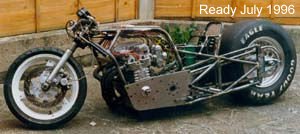


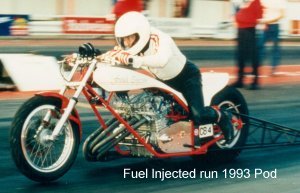
The best performance from this chassis was 8.45 and 156mph, at which point the chassis was trying to tie itself in knots. Reviewing contemporary video footage in slow motion was enough to convince us we needed to make major changes
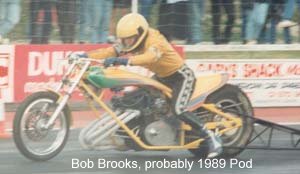
1992 to 1995
The first French Injection was the ex-Brooks brothers Yellow Metal Kawasaki Competition Bike. This was used until 1995, collecting runners up trophies for the 1993 Divisional Championship and the ACU Championship.
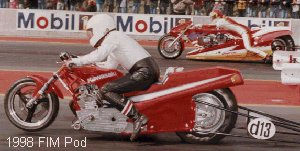
1997
This year was spent chasing problems, most famously, Steve eliminating himself by hitting the mirrors on a bye run. Throughout 97 the only set of mirrors not hit were the 60ft although they had a few near misses. The top end steering problem was traced to the aerodynamics of the faring forcing the bike to tip over. It now resides on Jerry Colliers H2 without problems.
1996
A new chassis was built for the 1996 season with Coll Rule, to take the Kawasaki engine from the old machine. Although it did not hit the track until the July Cannonball meeting, its' first full run was 8.31 seconds @ 154 mph, Steve's fastest ever run at that time & taking the event win.
The bike was unbeaten in the UK for the rest of the 1996 season and finished 5th in the ACU championship despite taking in only 3 meetings out of 8.
In the European Drag Bike class in Norway and in Hockenheim the bike ran into the sevens, although it refused to do so in the UK.
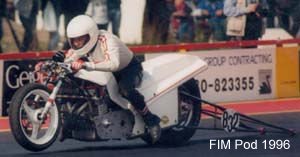
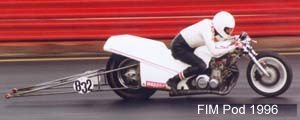
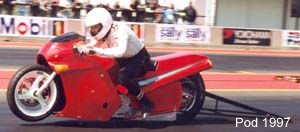
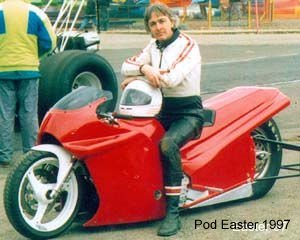
1998
This was the year it all worked. By this time the bike was running consistent mid seven second times with 165-170 mph terminals giving typically a half-second advantage over the rest of the field. In addition to event wins at Avon Park and Santa Pod Raceway, he collected the win in both tracks' championships as well as the ACU Championship
The season was topped off by winning the Nitro Olympics Drag Bike class at Hockenheim, Germany with a time of 7.51 seconds at 174 mph.
Due to mechanical failure in the penultimate round of the ACU, Jerry Collier offered his RD400 2-stroke twin to run in the last round, qualifying 5th and becoming the second rider into the nines on a Super twin Gas bike. The meeting was rained out, but the championship was ours.
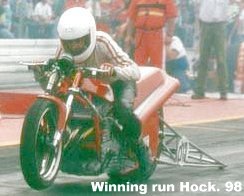
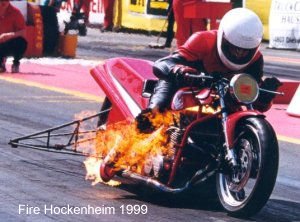
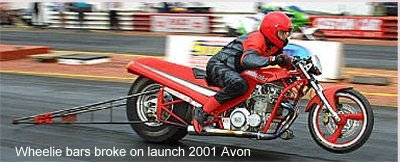
1999
This was a difficult year. The bike ran 7.6 second times, but suffered engine damage & huge fires. The biggest of these fires, captured by Karen de-Haas at Hockenheim. Revisions to the fuel and nitrous systems continued in the search for more reliable performance but the fires continued throughout 1999. ACU runner up to Chris Hall, Super Series Championship winner. Small consolation for an expensive year.
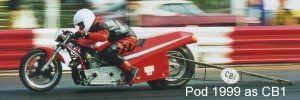
2000
This year we moved to funny bike and the search for more performance only this time without Gordon as crew as his wife was very ill. Most of the year was spent steering the bike, later traced to vertical wheel alignment. This hurt performance but not as much as chucking a rod out in June. Only a 7.5 as the best for the year, good enough for 4th in the ACU and 2nd in the Superseries.
A 150 mph bounce off the wall in the final round at Pod scuffed the leathers, made flat spots on the front brake lever and footrest. A comment noted from the tower to the top end crew, as they could not see though the dust, "is there a rider on that bike?", there was.
Lack of grip against Barry Eastman in the first round lost 2nd place in the ACU Championship to Ken Cooper.
2001
With Gordon back and a Schnitz controller the performance increased, and so did the fires. With broken wheelie bars in Aug, it was time for a slider. With lots of beer, some big lumps of ally and good friends had the slider fitted for a quick test at POD's RWYB. First pass was a twist and go 9 second run. Second pass with gas and launch button saw a comfortable 7.7
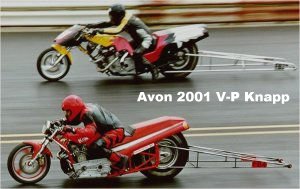

A few modifications to the electronics and a quick test at Pod cured the problem culminating in a 7.18 @ 192 mph win over Dave Bailey in June taking high terminal speed for the meeting and the track record for 2003..
Later at Pod, the new combination proved too much for the pistons, burning holes in two of them and cracking the others.
2002-2003
Steve took a year out to give the bank balance a rest. However the 2003 season started during 2002 with a 1500 big block & pistons from the US, bigger carbs, NOS solenoids, construction of a big valve 8 plug straight port head. The chassis was lengthened to 74" with new forks, new ally bars and lightening of the rear wheel. A new coat of paint from Rick Davis topped of the bike for the start of the season.
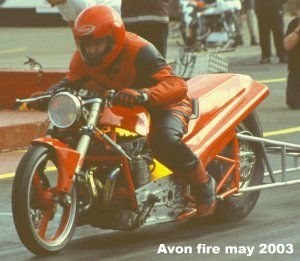
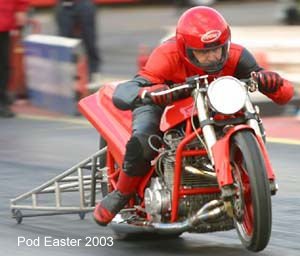
The Easter meet proved the basic design worked with 170mph but the head split in the 1st round trashing several hundred hours work.
The old 2001, 4 plug head was revived only to catch fire at Avon resulting in non qualification for this meeting. The bike is well fire proofed by now. This rear shot shows the flames right down inside the bike.
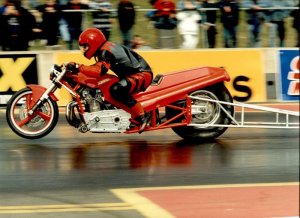
The last meeting of the year took its toll on the last of the parts with a first run failure due to a cooked clutch, and the second run repeating the head splitting of the first meet of the year.
The run was not all bad as the bike recorded 7.24 @180 on three cylinders from the 330 ft. Six second power, but not this year.
Continued. Click here
Home Bike Spec Photos The Team History Strip Tune NOS Thanks
A discussion with Tony Lang of MTC indicated the pistons failed due to detonation caused by a poor flame front, (and too much nitrous).
New Pro-mod pistons were fitted and the head was converted to 8 plugs. A "safe" setting on the first run was a 7.3, backed up later with a best ever 7.11. However in the 1st round the muppet on the bike pressed the wrong button to launch resulting in fire number 11. The bike suffered severe damage to 5 zip ties which had to be replaced.

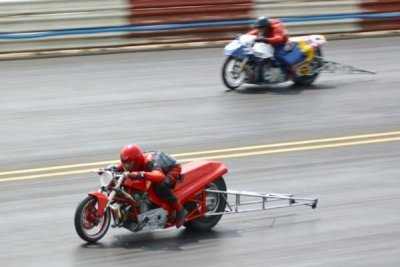
 |
 |
 |
 |
 |
 |
 |
 |